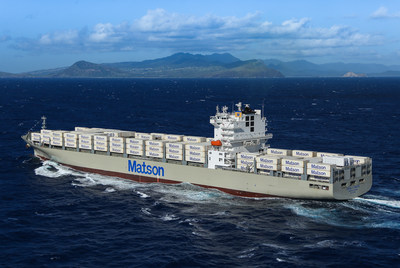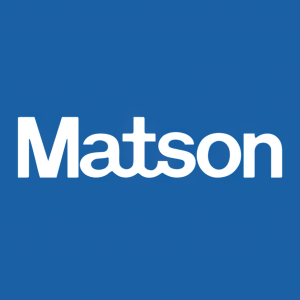MATSON TO ADD THREE LNG-POWERED ALOHA CLASS CONTAINERSHIPS
Matson, Inc. (NYSE: MATX) has announced a $1 billion investment to build three new Aloha Class containerships with Philly Shipyard. This addition is part of Matson's long-term decarbonization strategy aimed at reducing Scope 1 fleet emissions by 40% by 2030 and achieving net-zero by 2050. The first vessel is set for delivery in Q4 2026. Designed for the China-Long Beach Express service, these vessels will enhance speed and capacity while utilizing LNG-ready technology, aligning with the company's sustainability goals.
- Investment of $1 billion in three new Aloha Class containerships.
- First vessel delivery expected in Q4 2026, enhancing operational capacity.
- New ships equipped with LNG-ready technology, supporting decarbonization goals.
- Goals set for a 40% reduction in Scope 1 emissions by 2030.
- Significant financial obligation of $1 billion may strain resources.
- Dependence on the timely construction and delivery from Philly Shipyard poses risks.
- Forward-looking statements include uncertainties around environmental regulations and market conditions.
HONOLULU, Nov. 2, 2022 /PRNewswire/ -- Matson, Inc. ("Matson"; NYSE: MATX) today announced that its subsidiary, Matson Navigation Company, Inc., a leading U.S. carrier in the Pacific, has signed contracts with Philly Shipyard Inc. to build three new 3,600 TEU* Aloha Class containerships for an aggregate price of approximately
The new vessels will join two Aloha Class ships previously built for Matson by Philly Shipyard that entered service in 2018 and 2019, respectively. Like their sisterships, the new vessels will be equipped with dual fuel engines that are designed to operate on either conventional marine fuels or liquefied natural gas (LNG), as well as other "green ship technology" features, such as a fuel-efficient hull design and environmentally safe double hull fuel tanks and freshwater ballast systems. While the earlier ships require some modification to operate with LNG, the new ships will be delivered LNG-ready.
"Our existing Aloha Class ships are among the fastest, most efficient vessels in the Matson fleet," said Matt Cox, chairman and chief executive officer. "These new Jones Act compliant vessels will be built specifically for our China-Long Beach Express service, and like their sisterships, are expected to help Matson achieve its 2030 greenhouse gas emissions reduction goal while also providing additional capacity and speed benefitting our Hawaii service as well as the CLX."
The 854-foot Aloha Class vessels are the largest containerships ever built in the U.S. and are designed to operate at speeds in excess of 23 knots in support of Matson's service hallmark – timely delivery of goods.
Philly Shipyard is a leading U.S. commercial shipyard constructing vessels for operation in the domestic Jones Act trade lanes. Prior to Matson's first two Aloha Class ships, the shipyard delivered four newly built Jones Act containerships for Matson between 2003 and 2006.
"It is the ultimate compliment when a former customer returns for another project. We are proud of the six vessels previously delivered to Matson, and are again ready to execute and deliver this important project." said Steinar Nerbovik, Philly Shipyard president and chief executive officer.
The three new Aloha Class ships will replace three vessels currently deployed in Matson's China-Long Beach Express (CLX) service, which will in turn replace three older vessels currently deployed in its Alaska service, redeploying bigger and faster vessels into that trade lane.
Matson expects to finance the new vessels with cash currently in the Capital Construction Fund and through cash flows from operations, borrowings available under the Company's unsecured revolving credit facility and additional debt financings.
Matson has set corporate goals to achieve a 40 percent reduction in Scope 1 greenhouse gas (GHG) fleet emissions by 2030 and net-zero Scope 1 GHG emissions by 2050.
* TEU = Twenty-foot Equivalent Units, the standard unit of measurement for container capacity
Founded in 1882, Matson (NYSE: MATX) is a leading provider of ocean transportation and logistics services. Matson provides a vital lifeline to the domestic non-contiguous economies of Hawaii, Alaska, and Guam, and to other island economies in Micronesia. Matson also operates premium, expedited services from China to Long Beach, California, provides service to Okinawa, Japan and various islands in the South Pacific, and operates an international export service from Dutch Harbor to Asia. The Company's fleet of owned and chartered vessels includes containerships, combination container and roll-on/roll-off ships and custom-designed barges. Matson Logistics, established in 1987, extends the geographic reach of Matson's transportation network throughout North America. Its integrated, asset-light logistics services include rail intermodal, highway brokerage, warehousing, freight consolidation, Asia supply chain services, and forwarding to Alaska. Additional information about the Company is available at www.matson.com.
Statements in this news release that are not historical facts are "forward-looking statements," within the meaning of the Private Securities Litigation Reform Act of 1995, including without limitation those statements regarding vessel delivery dates, fleet capacity and efficiency, vessel speeds, fleet deployment, future vessel replacement expectations, financings, decarbonization strategy, and achievement of greenhouse gas emissions reduction goals. These statements involve a number of risks and uncertainties that could cause actual results to differ materially from those contemplated by the relevant forward-looking statement, including but not limited to risks and uncertainties relating to the occurrence of any event, change or other circumstances that could give rise to the termination of the vessel construction agreements; the ability of the shipyard to construct and deliver the Aloha Class vessels; repeal, substantial amendment or waiver of the Jones Act or its application, or our failure to maintain our status as a United States citizen under the Jones Act; changes in economic conditions or governmental policies, including from the COVID-19 pandemic; fuel prices, our ability to collect fuel related surcharges and/or the cost or limited availability of required fuels; evolving stakeholder expectations related to environmental, social and governance matters; timely or successful completion of fleet upgrade initiatives; the occurrence of poor weather, natural disasters, maritime accidents, spill events and other physical and operating risks, including those arising from climate change; transitional and other risks arising from climate change; the magnitude and timing of the impact of public health crises, including COVID-19; war, terrorist attacks or other acts of violence; loss of key personnel or failure to adequately manage human capital; changes in our credit profile and our future financial performance; our ability to obtain future debt financings; continuation of the Title XI and CCF programs; costs to comply with and liability related to numerous safety, environmental, and other laws and regulations; and disputes, legal and other proceedings and government inquiries or investigations. These forward-looking statements are not guarantees of future performance. This release should be read in conjunction with our Annual Report on Form 10-K for the year ended December 31, 2021 and our other filings with the SEC through the date of this release, which identify important factors that could affect the forward-looking statements in this release. We do not undertake any obligation to update our forward-looking statements.
Investor Relations inquiries: Lee Fishman Matson, Inc. 510.628.4227
| News Media inquiries: Keoni Wagner Matson, Inc. 510.628.4534
|
![]() View original content to download multimedia:https://www.prnewswire.com/news-releases/matson-to-add-three-lng-powered-aloha-class-containerships-301666764.html
View original content to download multimedia:https://www.prnewswire.com/news-releases/matson-to-add-three-lng-powered-aloha-class-containerships-301666764.html
SOURCE MATSON, INC. - PR
FAQ
What is the total investment Matson is making in new ships?
When will the new Aloha Class vessels be delivered?
How does the new investment impact Matson’s emission goals?
What is the significance of the Aloha Class ships for Matson?









